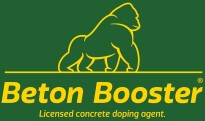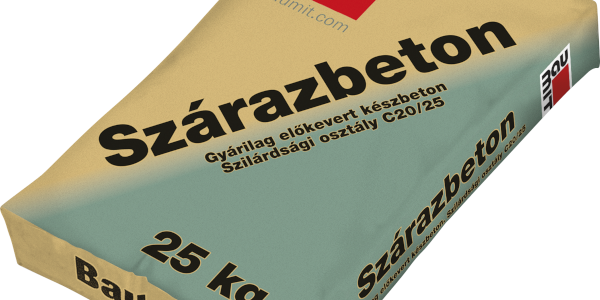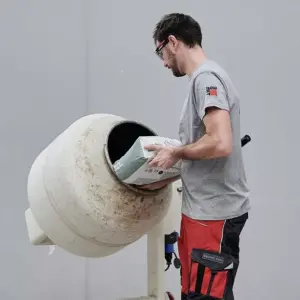What can dry mix concrete be used for?
Mainly for smaller concrete works, but we can also see construction sites where pallets of dry mix concrete are lined up. Dry mix concrete is a supporting product of our accelerated lifestyle. We want to achieve better results faster, whether in sports, our careers, or during renovations and construction. The construction industry has recognized this aspiration and has developed rapidly usable dry mix concrete.
The use of dry mix concrete in the following tasks:
- Sidewalks
- Beams, bridges
- Precast elements
- Concrete furniture, interior items
- Construction and repair of stairs
- Both outdoors and indoors.
Why is dry mix concrete beneficial?
Because it ensures consistent and reliable quality. I know they’ve been pouring concrete from gravel and cement for ‘ages,’ and there are concrete surfaces and structures that are centuries old and still intact. However, it’s much more common to see this kind of sight:
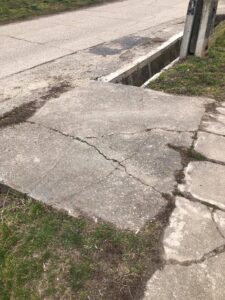
There could be several reasons why this parking space looks like this, but poor concrete quality is almost a given. They probably didn’t even include reinforcement mesh, or if they did, it might have been about 4 mm thick. They surely haven’t discovered the much simpler solution instead of using rebar: ArmoTec fiber-reinforced concrete. You can learn more by clicking on the link.
It’s also possible that the concrete foundation wasn’t properly prepared: a minimum of 10-15 cm thick compacted crushed stone bedding.
The use of dry mix concrete or bagged concrete always delivers the same quality. The outcome doesn’t depend on the expertise and condition of the person mixing the concrete; it’s a consistent result.
Using dry mix concrete is a particularly wise decision when facing smaller concrete projects.
In this case, there’s no need to haul half a truck of gravel and a few bags of cement home.
If you only need 2-3 buckets of concrete for a simple repair, such as after replacing a window or fixing a broken sewage pipe, it becomes incredibly easy. Just throw three bags of dry mix concrete into the car, mix it at home with water using a simple mixer attached to a drill, and you’re ready to use it. That’s how straightforward using bagged concrete is.
If proper concrete quality is essential, dry mix concrete can even be used for jobs requiring 1-2 cubic meters. To produce 1 cubic meter of ready-mix concrete, you need 2000 kg of dry mix concrete. So, from a 25 kg bag, you’ll get 12.5 liters of concrete.
Types of bagged concrete
- Dry mix concrete is the most common type, also known as Hobby concrete. It typically has a strength class of C16/20. Baumit dry mix concrete is classified as C20/25, while the strength class of Praktibau dry mix concrete is not readily available.
- Estrich concrete is used as a base for floor screeds. It has fine particles for easy smoothing and spreading, usually with a strength class of C16. Manufacturers often do not recommend outdoor use, but experience shows that if the concrete is properly done, it can withstand outdoor conditions.
- Lightweight concrete or perlite concrete is a mixture of concrete with polystyrene or perlite, making it lightweight yet solid. Don’t expect high strength; it’s more suitable for filling. Its insulation capability is negligible, and the quantity unit is usually in liters.
- Fast-setting concrete (Fixbeton, Mischnix column fixer, etc.) is concrete that sets within minutes. The products in parentheses are sprinkled dry into the column hole and around the column, then watered, and you wait a few minutes for it to set. No mixing is required.
- Rapid screed is a type of screed concrete that not only sets quickly but also dries rapidly, providing a surface that can be tiled within 1-2 days.
- Baumit All In concrete is the coolest dry mix concrete: you don’t even need to open the bag, just throw it into the mixer, and the bag dissolves. No mess, no environmental pollution, and the work is incredibly easy.
Dry mix concrete is much more expensive than the concrete mixed at home from gravel and cement.
It is also more expensive than ready-mix concrete. The price of industrial C16 concrete is around 20-25,000 HUF/m3, plus an additional 3-5,000 HUF delivery fee per cubic meter.
A bag of dry mix concrete is available for around 1,700 HUF at the beginning of 2023. To produce 1 m3 of concrete, you would need 80 bags, so the cost of 1 m3 of concrete would be 136,000 HUF. Additionally, the delivery of the 80 bags of concrete won’t be free.
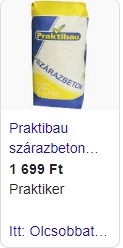
From this, you can see that it costs roughly four times as much as ready-mix concrete and 5-6 times more than concrete mixed at home. Therefore, it is cost-effective to use dry mix concrete when you only need a small quantity.
Dry mix concrete is not the same as ready-mix concrete
The term ready-mix concrete refers to concrete prepared at the plant and transported to the site with a mixer truck (or possibly a dump truck).
If you’re about to concrete, remember there’s a much cheaper and simpler solution than using reinforcing steel mesh: ArmoTec concrete reinforced with static macro fibers.
